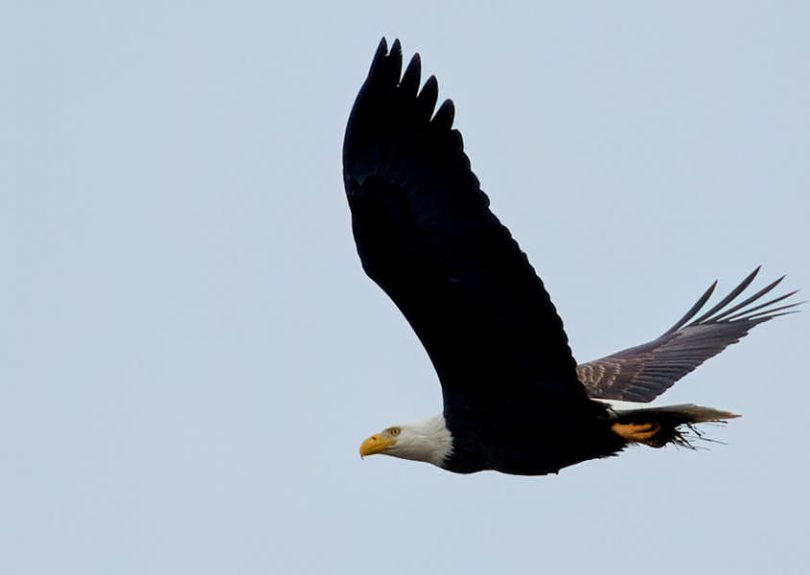Ellen Tinsley
Above: Kate “the mom” from First Nest at Jordan Lake carrying materials for her nest. PHOTO BY ELLEN TINSLEY © 2019 dreamsongs ellen tinsley dvm
The Bald Eagles of Jordan Lake saw water during the 2019-2019 breeding season—lots and lots of flooding waters. By the time the breeding season began Dec. 1, Hurricane Florence and Tropical Storm Michael had filled the lake to near-record heights above normal pool level of 216 feet. The high levels continued into the spring.
Many of those of us who monitor the bald eagles for the Army Corps of Engineers wondered to what extent the very high lake levels would impact the breeding season.
There was storm damage to some of the bald eagle nests. One nest was destroyed totally but the parents built a new one within feet of the old nest. Some of the bald eagle nests weren’t seen until late in the breeding season because the flooding prevented eagle monitors from getting to their viewing points. Usually each nest is seen about every two weeks during the breeding season.
There are about 16 bald eagle nests at Jordan Lake. The nests are the center of the bald eagle family and are therefore where the statistics are recorded. Birders (for all bird species) use the production of chicks at each nest to signal whether or not the season was successful.

Two Ranger Nest fledglings at Jordan Lake. PHOTO BY ELLEN TINSLEY © 2019 dreamsongs ellen tinsley dvm
Bald Eagles normally have two eggs and therefore two chicks in each family.
When a chick leaves the nest for its first flight, it is said to have fledged. As of this writing, Jordan Lake had 13 active nests for the 2018-2019 breeding season. Those 13 nests fledged 22 eaglets.
The stormy weather apparently had some impact on the breeding cycle. Some nests lagged behind their normal fledging times by more than two weeks. It is usual for some nests not to have fledglings at all or to only have one eaglet—nature is not cruel in these losses but she is harsh and only the very best chicks become fledglings.
All of the three nests I monitored for the Army Corps of Engineers—First Nest, H&G Nest and Ranger Nest— produced two fledglings each. The photos with this story are fledglings from nests I monitor.
I continue to watch the nests and record the antics of the fledglings as they explore the lake, pester their parents for another fish and chase any bird that they see.
If you would like to see the bald eagles at Jordan Lake, here are my rules of Bald Eagle watching:
1) Go to the closest boat ramp to you.
2) Bring all the patience you have.
3) Bring a camp chair or folding chair and be prepared to watch for a minimum of 2 hours—from the same place.
4) Bald eagles don’t like to have humans too close to them and by Federal Law you must stay at least 300 feet away—that is a football field away.
5) Bring binoculars or a camera with a long lens.
6) Again, have patience and sit and let the eagles come to you!
I hope each of you can get to the lake soon and see a bald eagle soaring past. We are very blessed to have the Jordan Lake Bald Eagle Paradise close by. The Jordan Lake State Recreation Area often holds talks about bald eagles so watch their website and come join us as we present lectures and walks to help you have the best chance at seeing a bald eagle.



